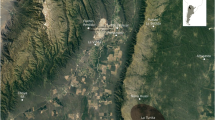Abstract
In the present paper the main results obtained, over a period of more than ten years, from a series of studies concerning the characterization of Italian Renaissance lustred majolicas (from Gubbio and Deruta, Umbria, Italy) are presented. Lustre decoration is a well-known technique, consisting in the application of a thin metallic iridescent film, containing silver and copper nanoparticles, over a previously glazed ceramic object. The technique had its origin in Persia (IX century), was imported by Moorish in Spain, and then developed in central Italy during the Renaissance period.
Numerous analytical techniques (among which, ETASS, XRD, UV–Vis, SEM-EDX) have been employed for the characterization of lustred ceramic shards, allowing one to acquire information on both lustre chemical composition and nanostructure. In this way it was shown how some technological parameters, such as the firing conditions, are mandatory to obtain the final result. The presence of a specific marker of the lustre Italian production, i.e., cosalite (Pb2Bi2S5), has been also highlighted.
From the study of the ceramic body composition (by means of XRD and ICP-OES and in particular of chemometric techniques) acquired on more than 50 ceramic shards it was possible to discriminate between Deruta and Gubbio production, in this way allowing one to assign objects of uncertain provenance to a specific site.
Finally, the most interesting results obtained studying excellent lustred masterpieces from Renaissance belonging to important museums are here presented. In particular, with the use of nondestructive techniques (PIXE, RBS, and portable XRD), the production of Mastro Giorgio Andreoli from Gubbio was investigated. By means of the same analytical approach, one of the first examples of lustre in Italy (the famous Baglioni’s albarello) was examined, and the controversial question of its attribution to Italian production was scientifically faced.





Similar content being viewed by others
References
A. Caiger-Smith, Lustre Pottery: Technique, Tradition and Innovation in Islam and the Western World (Faber and Faber, London, 1985)
C. Piccolpasso, Li Tre Libri dell’Arte del Vasaio, vol. 1557 (Edizioni all’insegna del Giglio, Firenze, 1976)
J. Pèrez-Arantegui, J. Molera, A. Larrea, T. Pradell, M. Vendrell-Saz, I. Borgia, B. Brunetti, F. Cariati, P. Fermo, M. Mellini, A. Sgamellotti, C. Viti, J. Am. Ceram. Soc. 84, 442 (2001)
G. Padeletti, P. Fermo, Appl. Phys. A 7(6), 515 (2003)
G. Padeletti, P. Fermo, Appl. Phys. A 77, 125 (2003)
G. Padeletti, P. Fermo, Appl. Phys. A 79, 241 (2004)
G. Padeletti, P. Fermo, Appl. Phys. A 79, 277 (2004)
G. Padeletti, G.M. Ingo, A. Bouquillon, S. Pages-Camagna, M. Aucouturier, S. Roehrs, P. Fermo, Appl. Phys. A 83, 475 (2006)
S. Berthier, G. Padeletti, P. Fermo, A. Bouquillon, M. Aucouturier, E. Charron, V. Reillon, Appl. Phys. A 83, 573 (2006)
G. Padeletti, P. Fermo, A. Bouquillon, M. Aucouturier, F. Barbe, Appl. Phys. A 100, 747 (2010)
P. Fermo, G. Padeletti, J. Nanosci. Nanotechnol. 12(11), 8764 (2012)
P. Sciau, Nanoparticles in Ancient Materials: The Metallic Lustre Decorations of Medieval Ceramics in the Delivery of Nanoparticles (InTech, New York, 2012). Ed. by A.A. Hashim
G. Padeletti, P. Fermo, Appl. Phys. A 100, 771 (2010)
T. Pradell, R.S. Pavlov, P.C. Gutiérrez, A. Climent-Font, J. Molera, J. Appl. Phys. 112, 054307 (2012). doi:10.1063/1.4749790
P. Fermo, F. Cariati, C. Cipriani, M. Canetti, G. Padeletti, B. Brunetti, A. Sgamellotti, Appl. Surf. Sci. 185, 309 (2002)
J.S. Moya, C. Pecharroman, I. Montero, R.P. Zapardiel, A.E. Cubillo, J.J. Reinosa, J.F. Fernandez, J. Am. Ceram. Soc. 94, 2067 (2011)
J.J. Reinosa, J.J. Romero, P. Jaquotot, M.A. Bengochea, J.F. Fernández, J. Eur. Ceram. Soc. 32, 277 (2012)
M.J. Baxter, C.E. Buck, in Modern Analytical Methods in Art and Archaeology, ed. by E. Ciliberto, G. Spoto. Chemical Analysis Series, vol. 155 (Wiley, New York, 2000), pp. 681–742
P. Fermo, E. Delnevo, M. Lasagni, S. Polla, M. de Vos, Microchem. J. 88, 150 (2008)
P. Fermo, F. Cariati, D. Ballabio, V. Consonni, G. Bagnasco Gianni, Appl. Phys. A 79, 299 (2004)
Acknowledgements
The authors gratefully acknowledge Soprintendenza of Perugia, Gubbio Town Council, Carola Fiocco, Gabriella Gherardi, Ettore Sannipoli, and Claudio Veroli.
Part of this study has been supported by the Eu-ARTECH transnational access European program. The authors want to acknowledge the help of the AGLAE technical team and, in particular, A. Bouquillon and M. Aucouturier, the coauthors of some of these studies.
Author information
Authors and Affiliations
Corresponding author
Rights and permissions
About this article
Cite this article
Padeletti, G., Fermo, P. Significant findings concerning the production of Italian Renaissance lustred majolica. Appl. Phys. A 113, 825–833 (2013). https://doi.org/10.1007/s00339-013-7725-0
Received:
Accepted:
Published:
Issue Date:
DOI: https://doi.org/10.1007/s00339-013-7725-0




